Hetman of Zaporizhian Cossacks
Historical term From Wikipedia, the free encyclopedia
Hetman of Zaporizhian Cossacks is a historical term that has multiple meanings.

Officially the post was known as Hetman of the Zaporizhian Host (Ukrainian: Гетьман Війська Запорозького, Hetman Viiska Zaporozkoho).[1] Hetman of Zaporizhian Cossacks as a title was not officially recognized internationally until the creation of the Cossack Hetmanate. With the creation of Registered Cossacks units their leaders were officially referred to as Senior of His Royal Grace Zaporozhian Host (Ukrainian: старший його Королівської Милості Війська Запорозького, Starshyi Yoho Korolivskoi Mylosti Viiska Zaporozkoho).[1] Before 1648 and the establishment of the Cossack Hetmanate there were numerous regional hetmans across the Dnieper-banks, who usually were starostas or voivodes.
The first widely recognized hetman of Zaporizhia was Dmytro Vyshnevetsky, after that several Polish starostas were added to the Hetman registry such as Lanckoroński and Daszkiewicz who also led their own Cossack formations. According to Mykhailo Hrushevsky they were not really considered as hetmans, at least by their contemporaries. Among others such starostas were Karpo Maslo from Cherkasy, Yatsko Bilous (Pereiaslav), Andrushko (Bratslav), and many others. Even Princes Konstanty Ostrogski and Bohdan Hlinski were conducting Cossack raids on Tatar uluses (districts).
The commanders of Zaporozhian Host (the Kish) often considered as hetmans in fact carried a title of Kish Otaman. As from 1572,[2] hetman was the unofficial title of commanders of the Registered Cossack Army of the Polish–Lithuanian Commonwealth. From the 1648 Bohdan Khmelnytsky uprising, Hetman was the title of the head of the Cossack state, the Cossack Hetmanate. Cossack hetmans had very broad powers and acted as supreme military commanders and executive leaders (by issuing administrative decrees).
After the split of Ukrainian territory along the Dnieper River by the Polish-Russian Treaty of Andrusovo 1667, there was an introduction of dual leadership for each bank, or for each Ukraine of Dnieper (left and right). After the Treaty of Andrusovo there existed two different Cossack Hetmanates with two Hetmans the one in Poland being called Nakazny Hetman of His Royal Mercy of Zaporizhian Host and the Russian one titled Hetman of His Tsar's Mercy of Zaporizhian Host.
Eventually the official state powers of Cossack Hetmans were gradually diminished in the 18th century, and finally abolished by Catherine II of Russia in 1764.
Starosta
- Przecław Lanckoroński (1506–1512), not an actual hetman, he was a starosta of Khmilnyk
- Ostap Dashkevych (1506–1536), not an actual hetman, he was a starosta in charge of a defense force approved by the Sejm near Cherkasy. Dashkevych offered to create a defense force on the banks of the Lower Dnieper[3]
Cossack leaders
Summarize
Perspective
- Dmytro Vyshnevetsky (1550–1564), first who created a Cossack garrison at the Nyz Dnieprovski (Lower Dnieper) on the island of Small Khortytsia in 1552[4][5]
- Bohdan Ruzhynsky, member of Volhynia princedom, a leader who was sponsored by Moscow[4]
- Ivan Svirgovsky (1567–1574)
- Ivan Pidkova (1577–1578), leader
- Ivan Orishevsky (1579–1591)
- Bogdan Mikoshinsky (1586–1594)
- Kryshtof Kosynsky (1591–1593), otaman led the 1590 uprising after Janusz Ostrogski confiscated his lands near Bila Tserkva that were awarded to him by the Sejm
- Hryhory Loboda (1593–1596), Hetman of Zaporizhia
- Severyn Nalyvaiko (1596), an Ostrogski recruit who fought against the Kosiński Uprising, led his own uprising in Podolie and Volhynia independent from Hryhory Loboda
- Lubny massacre, a massacre that was conducted by the Polish army led by Hetman Zolkiewski. After that battle the Cossack movement was greatly reduced within the Polish–Lithuanian Commonwealth
- Krempski, Hetman of Zaporizhia, was elected during the siege near Lubny and later managed to escape with a small number of other cossacks
- Vasylevych, Hetman of Zaporizhia
- Nechkovsky, Hetman of Zaporizhia
- Tykhin Baybuza (1597–1598), Hetman of Zaporizhia
- Samiylo Kishka (1599–1601), Hetman of Zaporizhia, managed to reinstate the rights of cossacks in the Polish–Lithuanian Commonwealth
- Petro Konashevych-Sahaidachny led successful campaigns against the Tatars and the Turks, aided the Polish army at Moscow in 1618 and at the Battle of Khotyn in 1621. He also saw Cossack interests in the independence of Ukraine from Poland.
- Mykhailo Doroshenko (1623–1628)
- Hryhoriy Chorny (1628–1630), elected by Registered Cossacks
- Taras Fedorovych (1629–1630), elected by unregistered Cossacks
- Ivan Sulyma (1630–1635)
- Ivan Petrizhitsky-Kulaga (1631–1632)
- Tomilenko (1635–1637)
- Savva Kononovych (1637), former Pereyaslav polkovnyk
- Pavel Mikhnovych, better known as Pavel Pavluk, the leader of 1637 uprising
- Karp Skydan, Pavlyuk's assistant, headed the 1637 uprising while Pavlyuk returned to Zaporizhia
- Battle between Moshny and Ros on 6 December 1637
- Ilyash Karaimovych (1637), Mykola Potocki's appointee of Registered Cossacks, Bohdan Khmelnytsky was appointed a pysar of Karaimovych.
- Dmytro Hunia (1638), leader in Zaporizhia
- Major General Pyotr Mikhailovich Skarzhinsky (1788), He served as an officer in the Siberian Carabinieri and Taganrog Dragoon Regiments. Commander of the Astrakhan Cossacks and the 1st Commander of Buh Cossacks Army.[6][7]
Hetmans of Cossack Hetmanate
| No. | Hetman | Elected (event) | Took office | Left office | |||
|---|---|---|---|---|---|---|---|
| 1 |  |
 |
Bohdan Khmelnytsky (1596–1657) Зиновій-Богдан Хмельницький |
1648 (Sich) | 26 January 1648 | 6 August 1657 | died |
| 2 |  |
 |
Yurii Khmelnytsky (1641–1685) Юрій Хмельницький |
death of his father | 6 August 1657 | 27 August 1657 | reconsidered by the Council of Officers |
| 3 | 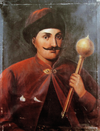 |
 |
Ivan Vyhovsky (????–1664) Іван Виговський |
1657 (Korsun) | 27 August 1657 (confirmed: 21 October 1657) |
11 September 1659 | surrendered title |
| 4 |  |
 |
Yurii Khmelnytsky (1641–1685) Юрій Хмельницький |
1659 (Hermanivka) | 11 September 1659 (confirmed: 11 September 1659) |
October 1662 | surrendered title |
| – | Pavlo Teteria (1620?–1670) Павло "Тетеря" Моржковський |
1662 (Chyhyryn) | October 1662 | July 1665 | (legitimacy questioned) | ||
| 5 | 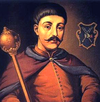 |
 |
Ivan Briukhovetsky (1623–1668) Іван Брюховецький |
1663 (Nizhyn) | 27 June 1663 (confirmed: 27 June 1663) |
17 June 1668 | died |
| 6 | 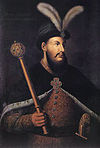 |
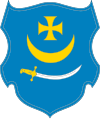 |
Petro Doroshenko (1627–1698) Петро Дорошенко |
1666 (Chyhyryn) | 10 October 1665 (confirmed: January 1666) |
19 September 1676 | surrendered to Ivan Samoylovych |
| – | Demian Mnohohrishny (1631–1703) Дем'ян Многогрішний |
1669 (Hlukhiv) | 17 December 1668 (confirmed: 3 March 1669) |
April 1672 | arrested and exiled to Siberia | ||
| 7 | 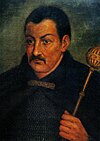 |
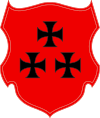 |
Ivan Samoylovych (1630s–1690) Іван Самойлович |
1672 (Cossack Grove) | 17 June 1672 | August 1687 | arrested and exiled to Siberia |
| 8 |  |
 |
Ivan Mazepa (1639-1709) Іван Мазепа |
1687 (Kolomak) | 4 August 1687 | 6 November 1708 | "stripped" of a title, discredited |
| 9 | 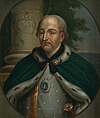 |
 |
Ivan Skoropadsky (1646–1722) Іван Скоропадський |
1708 (Hlukhiv) | 6 November 1708 | 14 July 1722 | died |
| – | Pavlo Polubotok (1660–1724) Павло Полуботок |
appointed hetman | 1722 | 1724 | died in prison | ||
| Collegium of Little Russia (Stepan Velyaminov) 1722-1727 | |||||||
| 10 |  |
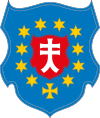 |
Danylo Apostol (1654–1734) Данило Апостол |
1727 (Hlukhiv) | 12 October 1727 | 29 March 1734 | died |
| – | Yakiv Lyzohub (1675–1749) Яків Лизогуб |
appointed hetman | 1733 | 1749 | died | ||
| provisional Hetman Government Administration 1734-1745 | |||||||
| 11 |  |
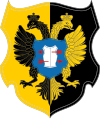 |
Kyrylo Rozumovsky (1728–1803) Кирило Розумовський |
1750 (Hlukhiv) | 22 February 1750 | 1764 | resigned |
| Collegium of Little Russia 1764-1786 (Pyotr Rumyantsev) | |||||||
Historians such as Mykola Arkas[8] question legitimacy of the Teteria's elections accusing the later in corruption.[9] Also some sources claim election of Teteria being taken place in January 1663.[10] The election of Teteria led to the Povoloch Regiment Uprising in 1663, followed by bigger number of unrest in the modern region of Kirovohrad Oblast as well as Polesie (all in the Right-bank Ukraine).[11] Moreover, the political crisis that followed the Pushkar–Barabash Uprising divided the Cossack Hetmanate completely on both bank of Dnieper River.[11] Coincidentally, on 10 January 1663, the Tsardom of Muscovy created the new Little Russian Office (Prikaz) within its Ambassadorial Office.
Vouched by Charles Marie François Olier, marquis de Nointel, Yuriy Khmelnytsky was freed from the Ottoman captivity, appointed and along with Pasha Ibragim was sent to Ukraine fight the Moscow forces of Samoilovych and Romadanovsky. In 1681 Mehmed IV appointed George Ducas the Hetman of Ukraine, replacing Khmelnytsky.
Following the anathema on Mazepa and the election of Ivan Skoropadsky, Cossack Hetmanate was included into the Russian Government of Kiev in December 1708. Upon the death of Skoropadsky, the Hetman elections were disrupted and were awarded as a gift and a type of princely titles, first to Moldavian nobleman and later to the Russian Empress favorite.
On 5 April 1710 the council of cossacks, veterans of the battle at Poltava, elected Pylyp Orlyk as the Hetman of Ukraine in exile. Orlyk waged a guerrilla warfare at the southern borders of the Russian Empire with the support from Ottoman and Swedish empires.
Tsardom of Russia appointed hetmans
- Ivan Bezpaly, elected by some cossacks in the town of Varva
- Demian Mnohohrishny, "Siverian Hetman"
Polish appointed hetmans
The Appointed Hetman Mykhailo Khanenko was elected the Hetman of Ukraine by a council of Sukhoviy's Cossacks in Uman to depose Doroshenko. In 1675 John III Sobieski awarded the title to some Ostap Hohol (died in 1679). Same thing happened in 1683 when John III Sobieski awarded the title to Stefan Kunicki and in 1684 to Andriy Mohyla. Those awards were given during the Great Turkish War.
- Pavlo Teteria
- Mykhailo Khanenko, appointment confirmed by the King of Poland Michal Korybut Wisniowiecki
- Ostap Hohol, appointment confirmed by the King of Poland John III Sobieski
- Stefan Kunicki, appointment confirmed by the King of Poland John III Sobieski
- Andriy Mohyla, appointment confirmed by the King of Poland John III Sobieski
- Samiylo Samus, title surrendered to Ivan Mazepa
| No. | Hetman | Elected (event) | Took office | Left office | |||
|---|---|---|---|---|---|---|---|
| (1) |  |
Mykhailo Khanenko (1620–1680) Михайло Ханенко |
1669 (Uman) | 1669 (confirmed: 2 September 1670) |
1674 | pro-Polish faction[a] | |
| (2) |  |
Stefan Kunicki (?–1684) Стефан Куницький |
23 August 1683 | 23 August 1683 (confirmed: 24 August 1683) |
January 1684 | pro-Polish faction | |
| (3) | 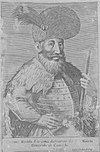 |
Andriy Mohyla (?–1689) Андрій Могила |
January 1684 | January 1684 (confirmed: 30 January 1684) |
January 1689 | pro-Polish faction | |
Sanjak-bey, Prince of Sarmatia (Turkish appointments)
In 1669 Petro Doroshenko received a title of Sanjak-bey from Mehmed IV. Title existed in 1669 to 1683.
Hetman in exile
The title existed in 1710–1760.[12]
See also
Notes
- Following the truce of Andrusovo, the Polish government was appointing its own hetmans of Zaporizhian Host on its territory (so called Right-bank Ukraine). It is unknown whether the position performed any administrative functions over the territory.
References
External links
Wikiwand - on
Seamless Wikipedia browsing. On steroids.
